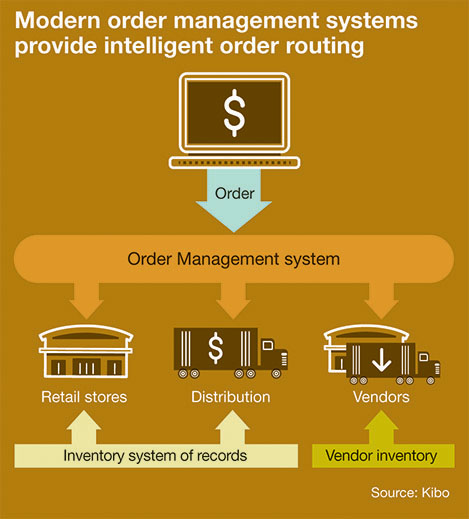DOM’s impact on customer experience
Distributed order management suppliers and users tout its ability to strengthen the customer experience through better ties to store-level systems to improve buy-online/pickup-in-store efforts and to empower store associates.
E-commerce has made distributed order management (DOM) systems—a layer of software that sits above inventory systems and figures out how to best fulfill orders—a key part of omni-channel strategies. The routing logic in DOM quickly assesses which warehouses, stores or third-party locations should be tapped to fill an order, regardless of channel.
In short, DOM brings efficiency to fulfillment. But that’s the internal view of DOM, also known as an order management system (OMS). As omni-channel retailers seek to make stores more useful for customers who buy online, DOM’s ability to improve the customer experience is gaining attention. For options such as buy online/pick up in store (BOPIS) to work effectively, the foundation will likely involve an OMS that integrates with store-level solutions.
DOM functionality has centered around order routing, inventory visibility, order modification and ship-from-store features, says Zach Zalowitz, practice lead for omni-channel supply chain at consulting firm SCApath. While the functions OMS vendors are expanding on varies by industry, more attention is being paid to integration with store solutions, says Zalowitz.
“There are two main questions involved in designing your OMS solution: Do all my commerce systems ‘speak’ the same language, interface-wise; and second, is the business logic interpreted the same?” says Zalowitz. “The better those two questions are answered, the more value retailers will find in their solution.”
DOM typically integrates with multiple systems to gain knowledge of inventory, logistics and labor issues. DOM integrates with warehouse management system (WMS) solutions to know what is on hand in distribution centers, as well as with store-level systems including point of sale (POS), merchandising or other inventory systems.
“One key area of focus for vendors is around store labor and capacity planning to enable better order routing decisions,” says Zalowitz. “The more finely tuned you can be around showing what labor is available for each part of each day, the more it helps manage order allocations properly. It’s not enough just to route an order to a store because that is the inventory point closest to the customer—you need the people there to service those orders.”
Today’s DOM/OMS solutions are different from the order management in enterprise resource planning (ERP) systems. ERP order management was conceived of at a time when supply chains were more linear, with a DC shipping to stores in its region, and little variation beyond that, notes Brian Kinsella, vice president for product management for Manhattan Associates’ OMS solution.
“The supply network for omni-channel has gotten far more complicated,” says Kinsella. “What’s all the rage now is turning stores into fulfillment points, so now you’ve just added hundreds—or in some cases thousands—of potential points of fulfillment to a network.”
Stores as DCs?
DOM solutions may not be able to turn stores into tightly controlled DC environments, but they can use integration capabilities, rules and software intelligence to reliably figure out how much available goods are in specific stores without disappointing either e-commerce or walk-in customers.
Stores tend to be chaotic environments for inventory control, especially outside the backroom, where customers are moving goods, trying them on or purchasing them. As result, says Zalowitz, as part of an enterprise order management (EOM) project, omni-channel retailers may need to consider an inventory protection strategy.
Under these strategies, says Zalowitz, an appropriate stocking level is set for each item by department and store so there is enough “protected” inventory to avoid stock outs in stores, while also guarding against committing to online sale of items in a store that could prove difficult to locate. Factors such as how deep to set the inventory for an item, its sales velocity, and how prone an item is to loss or “shrinkage,” are typically taken into account in inventory protection. “The critical misstep some retailers take is to use ‘blanket’ protection across the board for all items in the store, which leads to lost sales,” Zalowitz says.
While most DOM solutions have logic to support inventory protection, explains Zalowitz, inventory updates from store-level systems present further opportunities for fine-tuning protection levels because the OMS knows what is on hand.
For most retailers, a merchandising system integrates with a POS to give DOM a complete view of inventory. Intra-day signals from a POS give a DOM a more real-time inventory view. Without this signal, Zalowitz explains, the protection levels must increase to offset “stale” inventory knowledge. “The best DOM in the world is only going to be as effective as the data you feed into it,” he says. 
 DOM vendors may offer merchandising or POS solutions as well, and in these cases, they have typically pre-integrated the solutions so OMS can get timely updates. “A DOM system is opened up pretty deeply with application programming interfaces (APIs) because it relies on data from other systems to work,” says Ian Rawlins, strategy leader at Aptos, a vendor that offers DOM, POS and other retail solutions. “By contrast, some point-of-sale systems, especially the older ones, are like closed universes. They are a little more difficult to work with, even though we can use our APIs to push and pull data.”
DOM vendors may offer merchandising or POS solutions as well, and in these cases, they have typically pre-integrated the solutions so OMS can get timely updates. “A DOM system is opened up pretty deeply with application programming interfaces (APIs) because it relies on data from other systems to work,” says Ian Rawlins, strategy leader at Aptos, a vendor that offers DOM, POS and other retail solutions. “By contrast, some point-of-sale systems, especially the older ones, are like closed universes. They are a little more difficult to work with, even though we can use our APIs to push and pull data.”
Many retailers have been adopting new POS solutions the last couple of years, says Rawlins, first to prepare for chip cards, but more recently, to have an interoperable POS for omni-channel. With Aptos’s suite of solutions, he adds, the DOM and POS can work together to simplify things for the customer, so that if a customer at the store wants to order a couple of items from the store’s e-commerce site and buy one item in person, the Aptos software can do it in one transaction.
“The way we think about order management, with every decision we make about how the software works, we put the customer in middle of it and then wrap the software around those workflows,” says Rawlins. One of Aptos’s customers drawn to this blending of software needed for in-store retailing and online order management is TUMI, a luggage brand that sells online as well as through its own stores and other retail partners. Earlier this year, Aptos announced that TUMI, an existing customer for Aptos’s software including POS and customer relationship management solutions, selected Aptos Enterprise Order Management for DOM duties.
The overall solution is aimed at enabling TUMI to integrate physical and online retail channels, and enable shoppers who go into stores to have “endless aisle” fulfillment options. Flexibility for TUMI’s customer is the goal, says Rob Cooper, general manager for TUMI North America, in an Aptos announcement. “Aptos Enterprise Order Management will allow us to present our vast product assortment to customers in an ‘endless aisle’ format, while ensuring products can be fulfilled with the customers’ convenience in mind.”
DOM’s integration points
DOM solutions have other key points of integration besides store-level systems, points out Fab Brasca, vice president of solution strategy with JDA, though certainly a view into store inventory and store labor is critical for BOPIS. JDA is a partner with IBM’s Sterling Commerce for DOM software, combining IBM’s DOM with JDA’s lineup of supply chain management software, including WMS and some planning software.
 For example, the integration can link DOM with JDA’s replenishment planning so the true source of demand can be considered, which can be tricky for omni-channel retailers. For example, a customer may walk into the store, where an associate orders a product for home delivery fulfilled from a DC.
For example, the integration can link DOM with JDA’s replenishment planning so the true source of demand can be considered, which can be tricky for omni-channel retailers. For example, a customer may walk into the store, where an associate orders a product for home delivery fulfilled from a DC.
The true point of demand is the store, so ideally, explains Brasca, DOM should link with replenishment planning to consider such patterns. “In today’s world, when you think about replenishment, you need to capture these multiple points of data for a single transaction to truly understand where that inventory should be in the future,” says Brasca.
DOM’s tie to transportation management software also is critical to be able to instantly figure out the logistics involved in consolidating multiple items for an online order for store pickup when those items are in multiple stores, DCs, or a combination of both. Brasca says this “click and collect” capability relies on DOM that integrates with WMS and store inventory systems, as well as transportation management, to work correctly. “When we talk about click and collect, we are enabling multiple points of integration to handle the complexity,” says Brasca.
Because DOM solutions typically need to integrate with multiple systems, DOM vendors need to provide excellent integration technology, says Jennifer Sherman, senior vice president of product and strategy for Kibo, a DOM vendor that also offers e-commerce and mobile POS software. “You have to have a robust integration layer—one that ensures that the integrations put in place don’t have to change even if the underlying software does,” says Sherman.
Kibo also offers some basic WMS-level functions, including the ability to pick, pack and ship as well as some wave planning, as part of its platform. Sherman calls it a “WMS light” capability that suits some of its users, though some may choose to integrate Kibo’s OMS with a separate WMS.
Customers at stake
At the store level, points out Sherman, store associates benefit from mobile apps that help them service customers who might want to order online while at the store. Retailers also should consider easily overlooked details such as signage for pickup up of online orders, as part of perfecting the customer experience. “Where we see most omni-channel efforts fail it’s because they did not involve the stores upfront, and think about all things involved in making their store associates successful,” says Sherman.
Inventory protection logic in DOM can help improve the customer experience by ensuring inventory in stores isn’t over-committed to online customers, or sold out for in-store shoppers. However, setting up protection rules in DOM can be time consuming, so one area of DOM evolution is in systems that self-adjust to demand and supply patterns, says Manhattan’s Kinsella. “We call it Adaptive Network Fulfillment,” he says. “It’s better if the system can be self-tuning, rather than having to have users configure 50 or 60 different flags.”
DOM solutions also should provide a means of handling exceptions or unexpected changes, such as weather events. “The best OMS providers have all made investments in better workflow-driven frameworks for exception management,” says Zalowitz. “Additionally, the DOM providers are investing in available to promise engines and in making store fulfillment functions easy to use, especially functionality on mobile devices.”
The overarching interest for both DOM vendors and users, says Zalowitz, is to strengthen the customer experience, whether it’s fulfillment for online orders or in-store workflows. To succeed, concludes Zalowitz, better, integrated software helps, but the real value is in designing processes that center on customer needs.
“I think where companies tend to miss the boat is that they think about processes like pick-up-in-store from a transactional viewpoint,” he says. “Rather, the leaders in omni-channel think about the customer’s journey first and work backwards from there. They need to think through: ‘what does the customer need here, and how can I make the experience seamless and convenient for them?’”
Companies mentioned in this article:

Article Topics
Software News & Resources
What generative AI means for supply chain work Reverse logistics in need of some love 2024 WMS Update: At the intersection of warehousing and e-commerce Vendor Evaluation Questionnaire for RFPs Supply Chain Management (SCM) applications keep the supply chain humming 6 TMS Trends for 2024 Getting ahead of the next supply and production disruption More SoftwareLatest in Logistics
LM Podcast Series: Assessing the freight transportation and logistics markets with Tom Nightingale, AFS Logistics Investor expectations continue to influence supply chain decision-making The Next Big Steps in Supply Chain Digitalization Warehouse/DC Automation & Technology: Time to gain a competitive advantage The Ultimate WMS Checklist: Find the Perfect Fit Under-21 driver pilot program a bust with fleets as FMCSA seeks changes Diesel back over $4 a gallon; Mideast tensions, other worries cited More LogisticsAbout the Author
About the Author
Subscribe to Logistics Management Magazine

Find out what the world's most innovative companies are doing to improve productivity in their plants and distribution centers.
Start your FREE subscription today.
April 2023 Logistics Management

Latest Resources
















